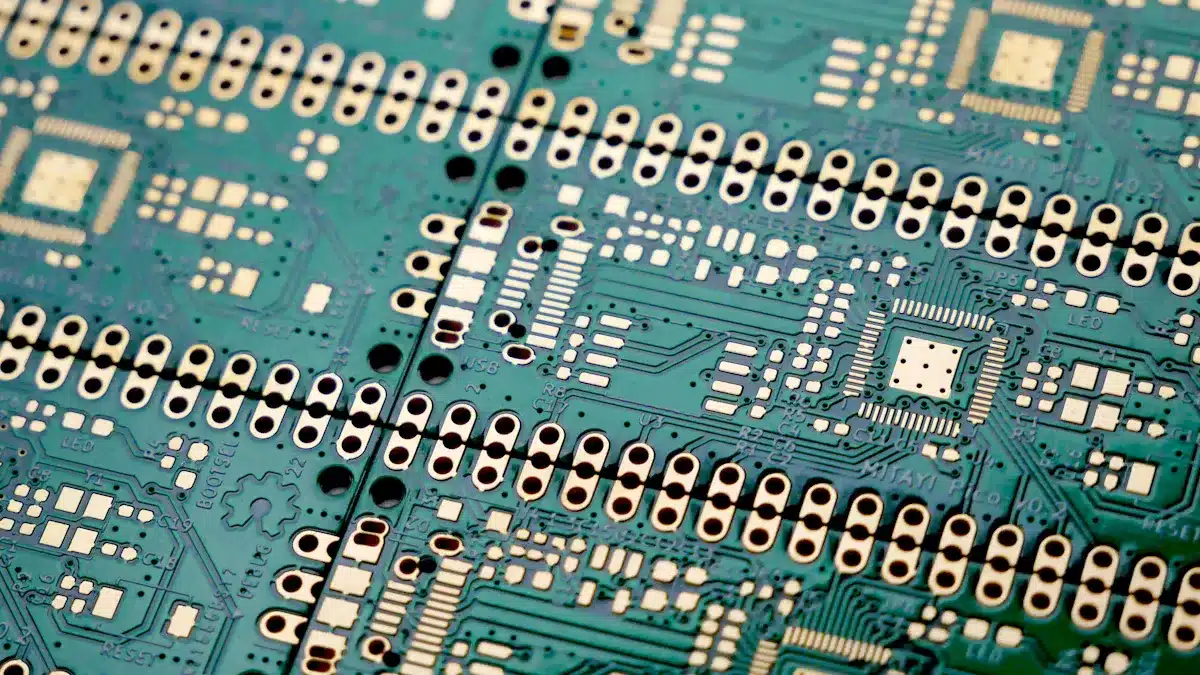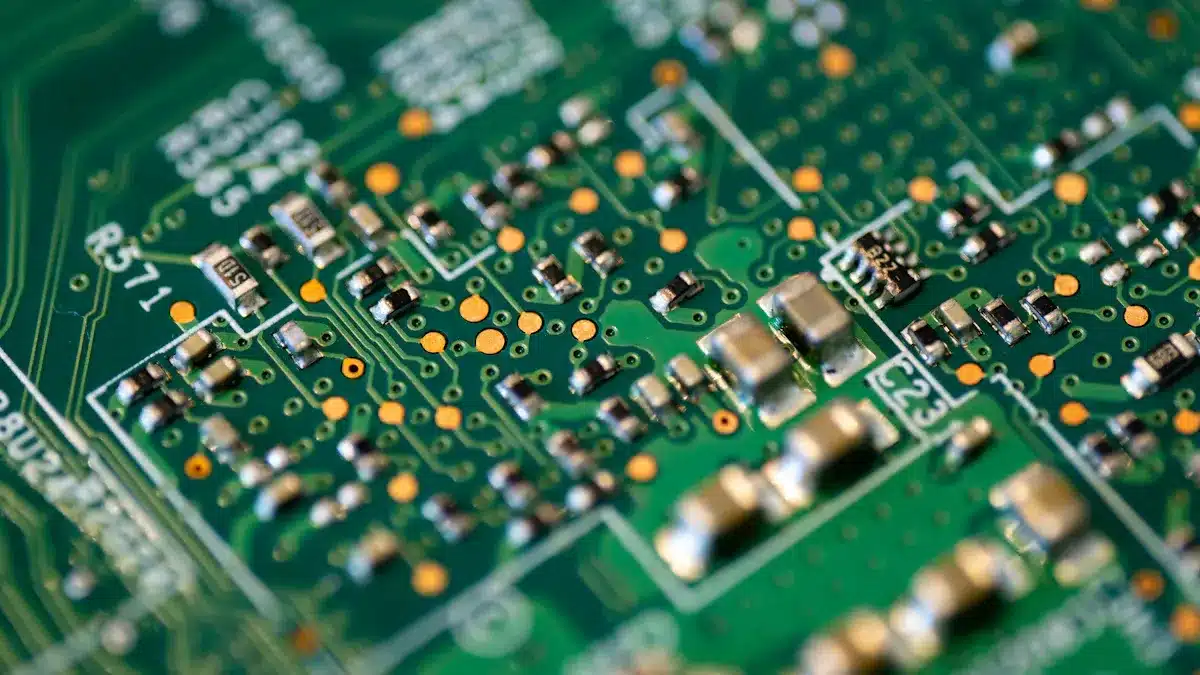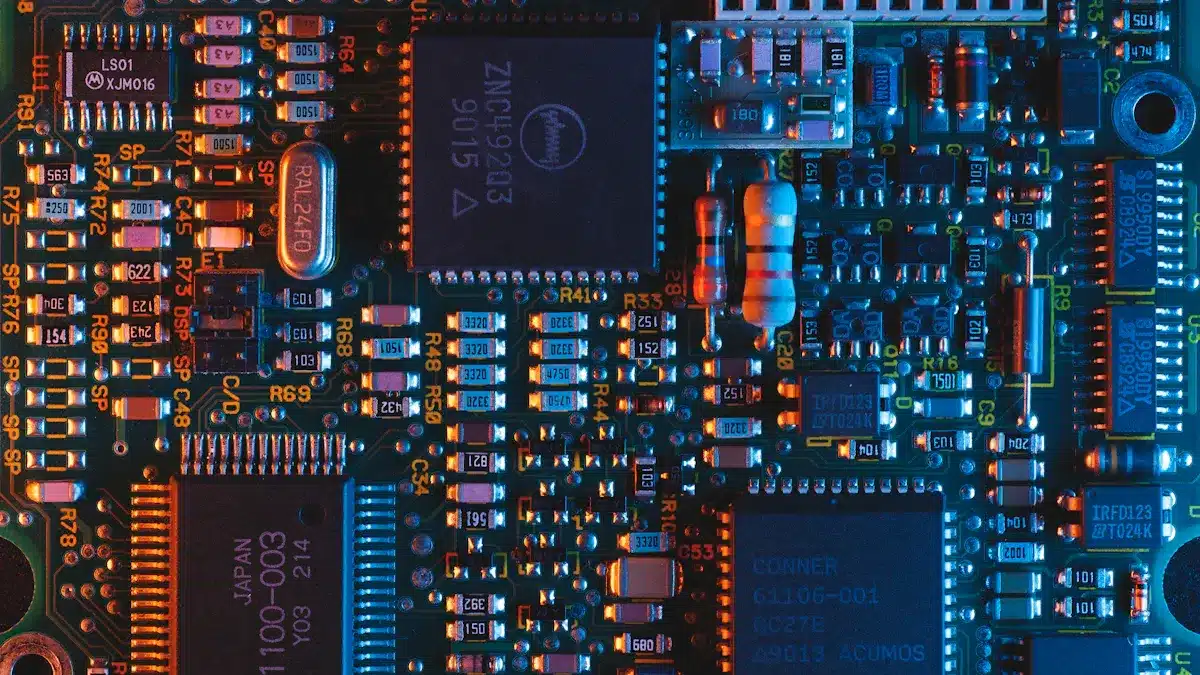
Printed circuit boards are very important in today’s electronics. They are the main part of almost all electronic devices. They help make manufacturing easier and cut down on wiring mistakes. As you look at electronics in 2025, knowing about different types of printed circuit boards is key. The worldwide PCB market is expected to grow a lot. This growth is due to more people using smartphones and other devices. This shows how important PCBs are in many industries, like consumer electronics and industrial uses.
Key Takeaways
Single-sided and double-sided PCBs work for simple and complex devices. This makes them useful for many applications.
Multi-layer and HDI PCBs are great in crowded spaces. They allow for better electronics with improved performance.
Flexible and rigid-flex PCBs meet modern design needs. They fit into small spaces while staying reliable.
Knowing about PCB types helps you make smart choices for electronic projects. This ensures good performance and saves money.
Keep up with new trends in PCB technology. This helps you use new materials and methods for better designs.
Overview of Printed Circuit Board Types

In 2025, you will see many types of printed circuit boards (PCBs). Each type is made for different uses and industries. Knowing these types helps you understand their importance in modern electronics.
Single-Sided PCBs
Single-sided PCBs are the easiest type of printed circuit board. They have one layer of copper on a base that does not conduct electricity. All electronic parts go on one side. The other side has copper lines that are etched.
Feature | Description |
|---|---|
Structure | Has one layer of copper on a non-conductive base. |
Component Placement | All parts are on one side, with copper lines on the other side. |
Manufacturing Complexity | Simple design means easier and faster to make. |
Reliability | Fewer failure points make them very reliable for basic uses. |
Assembly and Debugging | Easy for machines or hobbyists to put together; simpler to fix because there are no overlapping lines. |
You will find single-sided PCBs in simple devices like calculators, watches, and LED panels. Their easy design makes them cheap for low-end products.
Double-Sided PCBs
Double-sided PCBs have parts on both sides. This allows for more circuits in a small area. This design makes them harder to manufacture but improves their abilities.
Feature | Single-Sided PCBs | Double-Sided PCBs |
|---|---|---|
Manufacturing Complexity | Easier to make | Harder to make |
Cost | Usually cheaper | More expensive due to complexity |
Design Flexibility | Limited design choices | More design options |
Component Density | Fewer parts can fit | More parts can fit |
Best Use Cases | Simple electronics (e.g., thermostats) | Complex devices (e.g., car dashboards) |
Signal Integrity | Good for simple uses | Better for strong signal quality |
Thermal Management | Not great for heat control | Better at managing heat |
You will see double-sided PCBs in more complex devices like car dashboards, industrial controls, and phone systems. They offer more design options and better signal quality.
Multi-Layer PCBs
Multi-layer PCBs have three or more layers. They are good for high-density uses. These boards work better in fast electronics by allowing better connections and reducing interference.
Multi-layer PCBs can have from 2 to 40 layers.
They place signal and ground layers to protect sensitive signals.
Shorter paths help signals move faster, making them great for quick data processing.
You will find multi-layer PCBs in smartphones, computer motherboards, and aerospace systems. Their ability to fit more parts in smaller areas makes them important for advanced technology.
Rigid PCBs
Rigid PCBs are the most common type in consumer electronics. They have a solid base that supports the parts.
FR4 is the most common material made from flame-resistant epoxy and glass fabric.
Rigid PCBs are affordable and dependable, making them good for many uses.
You will see rigid PCBs in devices like TVs, computers, and appliances. Their strength and low noise improve signal quality, which is important for precise devices.
Flexible PCBs
Flexible PCBs can bend and twist, making them better at handling shocks and movement. They are made from flexible materials like polyimide, which helps them fit into tight spaces and be lighter.
Flexible PCBs use more bendable materials and have different making processes than rigid PCBs.
You will find them in consumer electronics, cars, and medical devices.
The need for flexible PCBs is growing, especially in areas that need small and light designs.
Rigid-Flex PCBs
Rigid-flex PCBs mix the benefits of rigid and flexible designs. They have both rigid and flexible parts in one board. This allows bending while keeping good electrical performance.
You will find rigid-flex PCBs in aerospace, medical devices, and portable electronics. Their design makes them smaller and lighter while staying reliable.
High-Density Interconnect (HDI) PCBs
HDI PCBs help make electronic parts smaller while improving performance. They allow more parts in less space, making them great for compact products.
HDI technology has helped the electronics industry grow.
The expected growth rate for HDI PCBs is 12.8% by 2025.
You will see HDI PCBs in smartphones, tablets, and advanced computers. Their ability to keep or improve performance while being denser makes them vital for modern electronics.
LED PCBs
LED PCBs are made for lighting uses. They often use metal materials to help with heat control, ensuring LEDs work well.
Good materials can handle tough conditions for reliable use.
You will find LED PCBs in car lights, commercial lights, and smart home tech.
The need for LED PCBs is increasing as industries focus on energy-saving lighting.
PCB Type Analysis
Definition and Characteristics
Every type of printed circuit board (PCB) has special features. These features make them good for certain uses.
Single-Sided PCBs: These boards have one layer of conductive material. They are simple and cheap, making them great for basic electronic devices.
Double-Sided PCBs: These boards have conductive layers on both sides. This allows for more complex designs. They can hold more components, which is important for advanced electronics.
Multi-Layer PCBs: These boards have three or more layers. They work well for high-density uses. They reduce interference and improve signal quality.
Rigid PCBs: Made from solid materials, rigid PCBs are strong and reliable. They are often used in consumer electronics.
Flexible PCBs: These boards can bend and twist. This makes them fit well in small spaces. You often find them in wearable technology.
Rigid-Flex PCBs: These boards mix rigid and flexible parts. They offer design options while keeping good performance.
High-Density Interconnect (HDI) PCBs: HDI boards allow for many components and advanced routing. They are great for compact and high-performance devices.
LED PCBs: These boards are made for lighting. They often use metal materials to manage heat well.
Applications in Industry
Different types of PCBs are used in various industries based on their features. Here’s a look at where they are used:
Type of PCB | Industrial Applications |
|---|---|
Single-sided PCBs | Simple electronic devices like calculators and sensors. |
Double-sided PCBs | LED lighting, industrial controls, and power monitoring. |
Multi-layer PCBs | Smartphones, aerospace systems, and medical devices. |
Rigid PCBs | Computers, automotive electronics, and consumer devices. |
Flexible PCBs | Wearable electronics like smartwatches and fitness trackers. |
Rigid-flex PCBs | Military, aerospace, and medical devices. |
High-frequency PCBs | Telecommunications, radar systems, and satellite communications. |
Aluminum-backed PCBs | High-power uses like LED lighting and automotive electronics. |
In fields like automotive and medical, the type of PCB chosen shows the need for reliability and performance. For example, in cars, PCBs must handle tough conditions to ensure safety and function.
Advantages and Limitations
Knowing the pros and cons of each PCB type helps you make smart choices. Here’s a summary:
PCB Type | Advantages | Limitations |
|---|---|---|
Single-Sided | – Low cost because of simple design and making process | – Limited routing options due to one conductive layer |
– Quick turnaround time for faster design and making | – Lower component density limits use in advanced applications | |
Double-Sided | – More complex routing and higher component density | – More complexity can lead to higher costs |
– Better signal quality and improved heat management | – Harder to make than single-sided boards | |
Multi-Layer | – Holds more components and complex circuits | – More expensive due to complicated making process |
– Reduces electromagnetic interference (EMI) and crosstalk | – Longer design and making times | |
Flexible | – Can bend and fit into tight spaces | – Usually more expensive than rigid boards |
Rigid-Flex | – Combines benefits of rigid and flexible PCBs | – Complex making process can raise costs |
HDI | – High component density and advanced routing options | – Very high making costs and complexity |
Environmental factors can also affect how different PCB types perform. For example, temperature and chemical exposure can change how long PCBs last and how reliable they are. Choosing the right resin type is important since each resin has its own pros and cons based on environmental conditions.
By understanding these points, you can pick the best printed circuit board for your needs.
Emerging Trends in PCB Technology

When you look at the future of printed circuit boards (PCBs), you will see exciting changes in materials, how they are made, and their designs. These new ideas will change electronics in 2025.
Innovations in Materials
New materials are changing how PCBs work and how friendly they are to the environment. Here are some important changes:
Innovation Type | Description |
|---|---|
Uses tiny holes and stacked copper layers for complex circuits in smaller spaces. | |
Flexible and Rigid Flex PCBs | Used for things like foldable phones and smartwatches, allowing for many layers. |
Improved Solder Mask Materials | Better solder flow and safe laminates for good heat control and standards. |
Sustainable Materials | Using safe laminates and materials that break down to help the environment. |
These changes not only improve performance but also help with environmental issues. For example, using flame-retarded PLA/flax materials can cut harmful waste by 90%. This move towards eco-friendly materials is important for a better future.
Advances in Manufacturing Techniques
Making PCBs has also improved a lot. Surface Mount Technology (SMT) allows for more parts in less space. This helps create smaller and lighter electronic devices. Machines and robots make the assembly process faster and cheaper. Here’s a summary of recent improvements:
Advancement Type | Description |
|---|---|
Makes smaller, lighter, and better devices with tiny parts and improved soldering methods. | |
Automation and Robotics | Makes the assembly process faster, cheaper, and better with robotic assembly lines. |
Environmental Sustainability | Using eco-friendly methods like lead-free solder and recyclable materials to help the environment. |
Future Directions for PCB Design
Looking forward, PCB design will change to meet new technology needs. Here are some expected trends:
Smaller consumer electronics will need high-density and complex PCB designs.
The healthcare field’s growing use of advanced medical devices and wearables needs reliable and compact PCBs.
Flexible Printed Circuit Boards will be important because they can handle stress and fit into tight spaces.
These trends show a bright future for PCBs, matching the technology needs expected in 2025. As you think about these changes, remember they will be key in shaping the electronics of tomorrow.
In conclusion, knowing about the different types of printed circuit boards (PCBs) is very important for anyone working with electronics. Each type, like single-sided and HDI PCBs, has special uses in many industries.
Key Takeaways:
Single-sided and double-sided PCBs are good for simple and complex devices.
Multi-layer and HDI PCBs work well in high-density uses.
Flexible and rigid-flex PCBs fit modern design needs.
As technology grows, PCBs will change even more. New materials and making methods will keep improving performance and being eco-friendly. Stay updated to make smart choices for your electronic projects! 🌟
FAQ
What is a printed circuit board (PCB)?
A printed circuit board (PCB) is a flat board that connects electronic parts. It uses metal paths to create circuits. PCBs are very important in almost all electronic devices, like smartphones and computers.
How do I choose the right PCB type?
To pick the right PCB type, think about your device’s size, complexity, and use. For simple devices, single-sided PCBs are good. For more advanced electronics, multi-layer or HDI PCBs are better choices.
What are the benefits of flexible PCBs?
Flexible PCBs are lightweight and can bend to fit in small spaces. They are great for wearable technology and devices that need to move. Their ability to bend makes them more durable and improves performance.
Can I recycle PCBs?
Yes, you can recycle PCBs. Many companies focus on recycling electronic waste. They take out valuable materials and help the environment. Always check local rules for the right disposal methods.
What is the future of PCB technology?
The future of PCB technology includes new materials and making methods. Expect more eco-friendly choices and designs for smaller, more complex devices. Improvements will keep changing electronics in 2025 and beyond.
See Also
Emerging Innovations in PCB and PCBA Design Practices
Benefits and Drawbacks of Flex PCBA in Electronics
Important Factors to Consider When Selecting PCB or PCBA
Comparing PCBWay with Other PCB Manufacturers in Detail
Investigating PCBA Testing Methods for Modern Electronics Production